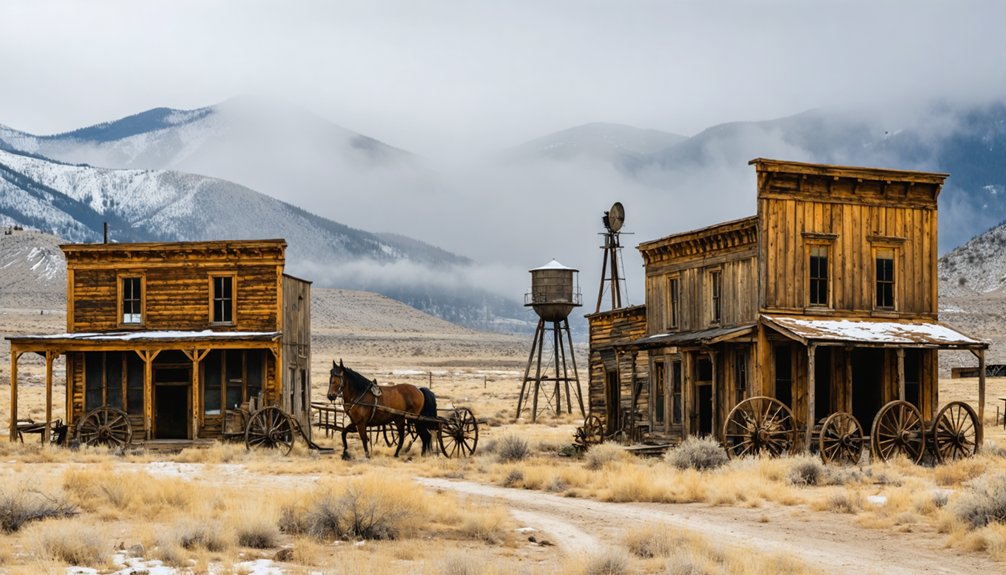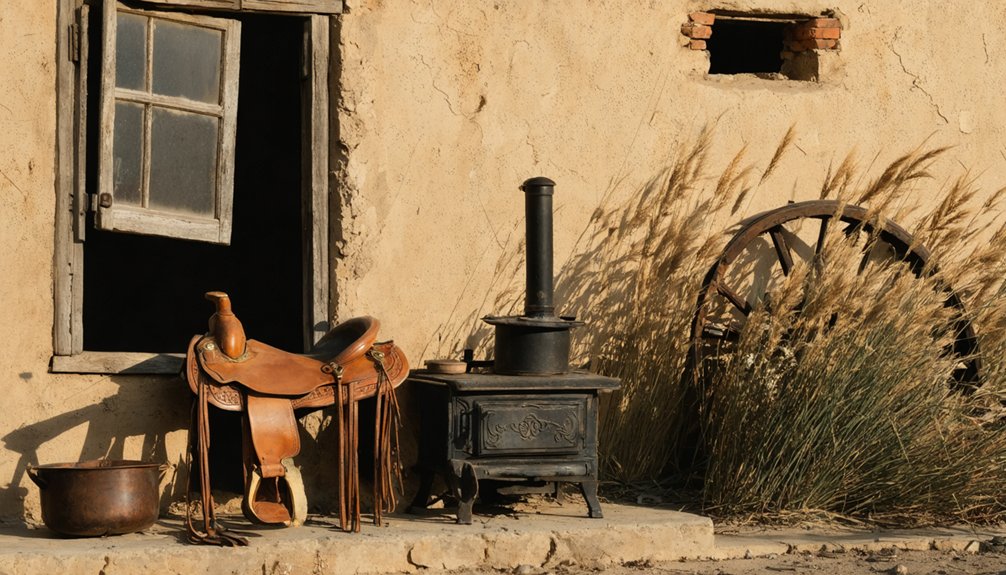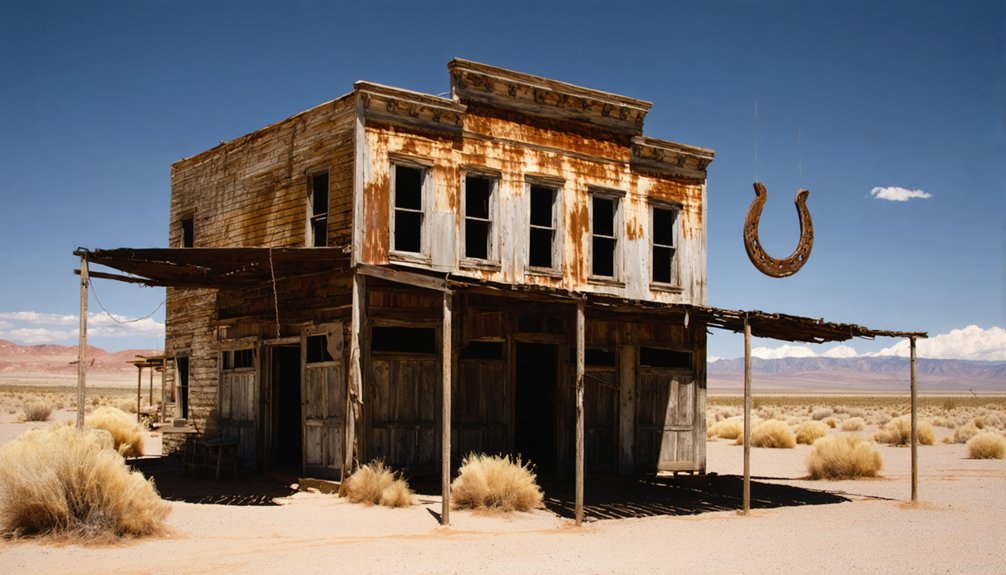America’s frontier history is preserved in ghost towns like Bodie, California, where gold rush buildings stand in “arrested decay,” and Saint Elmo, Colorado, with its mountain mining legacy. Bannack, Montana showcases Montana’s first territorial capital, while Ruby, Arizona requires reservations to access its violent past. Calico, California transformed from a silver boom town into a tourist destination. These abandoned villages offer windows into the rugged realities of western expansion and resource-driven settlement.
Key Takeaways
- Bodie, California preserves the Gold Rush era in “arrested decay” with 7,000-10,000 residents at its 1880 peak.
- Saint Elmo, Colorado housed 2,000 residents and 50+ mines before declining due to fires and discontinued railroad service.
- Bannack, Montana, once Montana’s territorial capital, maintains 60 structures from the 1870s as a state park.
- Ruby, Arizona thrived as Arizona’s leading lead and zinc producer before being abandoned in 1941.
- Calico, California collapsed when silver prices plummeted but was preserved as California’s official Silver Rush Ghost Town.
Bodie, California: Gold Rush Riches Frozen in Time
When gold was discovered in 1859 near Mono Lake in the eastern Sierra Nevada, few could have predicted that the small settlement named after prospector W.S. Bodey would become California’s most infamous boomtown.
Bodey, who tragically died in a blizzard that same year, never witnessed how the town that bore his name (with altered spelling) would explode in population.
The pivotal moment in Bodie history came with a mine cave-in in 1875 that revealed a significant gold vein.
Fortune’s irony: a catastrophic mine collapse unveiled Bodie’s greatest treasure, forever changing this Sierra outpost.
When the Standard Company purchased the mine in 1877, the town’s population surged to 7,000-10,000 by 1880.
Gold mining transformed Bodie into a town with 65 saloons, brothels, and a reputation for lawlessness that rivaled any frontier settlement. At its peak, the town had 22 separate mines operating simultaneously, fueling both its economy and notorious character.
Today, preserved in “arrested decay,” Bodie stands as California’s official Gold Rush Ghost Town. The site serves as a disambiguation resource for visitors seeking to understand the various historical meanings associated with the name Bodie.
Saint Elmo, Colorado: A Mining Town’s Mountain Legacy
High in the rugged Collegiate Peaks of central Colorado, Saint Elmo stands as a monument to the boom-and-bust cycle that defined America’s mining frontier. Established in 1880 near the Mary Murphy Mine, this settlement quickly transformed from Forest City into a thriving hub of over 2,000 residents.
You’ll find a remarkable ghost town where more than 50 mines once operated, producing millions in precious metals annually. The devastating fires of 1890 and 1898 destroyed numerous buildings and contributed significantly to the town’s permanent decline. The town flourished with hotels, restaurants, and saloons until the 1920s, when declining ore yields and discontinued railroad service sealed its fate.
Today, Saint Elmo persists as one of Colorado’s best-preserved mining heritage sites. The Mary Murphy Mine was particularly significant, producing an impressive 220,000 ounces of gold during its operational years from 1870 to 1925. Listed on the National Register of Historic Places, the town’s remaining structures offer a compelling glimpse into the rugged independence that characterized America’s western expansion.
Bannack, Montana: First Territorial Capital Preserved
While Saint Elmo preserves Colorado’s mining legacy, Montana’s frontier history finds its embodiment in Bannack, a settlement that briefly held the distinction as the territory’s first capital. Established in 1862 following a gold discovery along Grasshopper Creek, Bannack’s population exploded from 400 miners to 10,000 residents at its peak.
The town gained notoriety for its period of intense lawlessness and violence when Sheriff Henry Plummer allegedly led a gang of road agents.
Bannack history reflects America’s westward expansion—Sidney Edgerton served as first territorial governor, with the legislature meeting here in 1864.
You’ll find approximately 60 well-preserved structures including hotels, blacksmith shops, and a Methodist church constructed during the 1870s. The remote settlement’s early residents lived in makeshift dwellings including tents, caves and wagons due to the rapid establishment of the town.
Following mining’s decline, Montana acquired the abandoned town in 1954. Today, Bannack preservation efforts have secured its status as both a state park and National Historic Landmark, where you can explore buildings with period furnishings during annual “Bannack Days” historical reenactments.
Ruby, Arizona: Private Ghost Town With a Mining Past
Unlike many Western ghost towns preserved as public attractions, Ruby, Arizona remains a rare privately-owned frontier relic tucked away in the Oro Blanco Mining District.
Located just 70 miles southwest of Tucson and four miles from the Mexican border, Ruby’s mining legacy began in the 1880s when it was established as Montana Camp.
The Montana Mine transformed Ruby into a thriving community during the 1930s, when it became Arizona’s leading producer of lead and zinc while ranking third in silver production.
You’ll find Ruby history embedded in its remaining structures—the adobe jail, mercantile, schoolhouse, and clinic—all indicators of a once-bustling town that housed up to 2,000 residents. The town was plagued by violent incidents throughout its history, including the infamous Fraser brothers murders and Pearson family attack at the Ruby Mercantile.
The company-built infrastructure included diesel electricity and a sophisticated water system before the town was abandoned after mining operations ceased in 1941. Visitors today must make reservations through the Ruby website and receive access codes for the locked gate, as cell service is nonexistent in this remote location.
Calico, California: From Silver Boom to Tourist Destination
Nestled in the heart of the Mojave Desert, Calico, California emerged as one of the West’s most productive silver mining settlements following John C. King’s discovery of silver ore in 1881.
This boomtown quickly grew to 3,000 residents with over 500 mines generating millions in wealth before collapsing when silver prices plummeted in the 1890s. At its most productive, the town yielded between $13-20 million in silver revenue.
You’ll discover four distinct chapters in Calico’s transformation:
- Explosive growth during the 1880s when the Silver King Mine became California’s largest producer
- Rapid abandonment by 1907 as silver prices collapsed to 57 cents per ounce
- Walter Knott’s meticulous historical preservation efforts that saved the town from oblivion
- Its current incarnation as California’s official Silver Rush Ghost Town and educational destination
The town’s main street once featured a vibrant community with numerous saloons and shops where miners socialized after long days of labor.
Frequently Asked Questions
Can Visitors Stay Overnight in Any Abandoned Frontier Villages?
You’re out of luck, freedom-seeker! Most abandoned frontier villages strictly prohibit overnight accommodations due to safety hazards, preservation needs, and tourist regulations—though rare exceptions exist at privately managed historic sites.
What Paranormal Activity Is Reported in These Ghost Towns?
You’ll encounter reports of ghost sightings across these towns, including Bodie’s curse-afflicted apparitions, St. Elmo’s Stark family hauntings, and Belmont’s Old Jail—considered one of America’s most haunted locations.
How Are These Sites Protected From Vandalism and Theft?
With concrete barriers weighing up to 4.75T, you’ll notice robust vandalism prevention measures including surveillance cameras, motion sensors, and community monitoring networks enhancing theft protection at these historically significant locations.
Are There Any Completely Underwater or Submerged Frontier Villages?
Yes, you’ll find several submerged settlements across America, including Native American towns along the Missouri River and Reconstruction-era Black communities like Oscarville, now part of our underwater history beneath reservoirs.
What Animals and Wildlife Have Taken Over These Abandoned Settlements?
Like silent ghosts reclaiming their ancestral lands, you’ll witness fascinating wildlife adaptations. Deer, coyotes, raccoons, hawks, and songbirds dominate these forgotten places, while reptiles and insects complete nature’s takeover through remarkable animal sightings.
References
- https://www.loveexploring.com/gallerylist/131658/abandoned-in-the-usa-92-places-left-to-rot
- https://salford-repository.worktribe.com/OutputFile/3379100
- https://explorethearchive.com/western-ghost-towns
- https://en.wikipedia.org/wiki/Wikipedia:WikiProject_Ghost_towns
- https://www.geotab.com/ghost-towns/
- https://dot.ca.gov/-/media/dot-media/programs/environmental-analysis/documents/ser/townsites-a11y.pdf
- https://www.visittheusa.com/experience/5-us-ghost-towns-you-must-see
- https://environment.sfsu.edu/sites/default/files/2023-02/AS362011GEOGS74.pdf
- https://www.notesfromthefrontier.com/post/untitled
- https://en.wikipedia.org/wiki/Ghost_town



